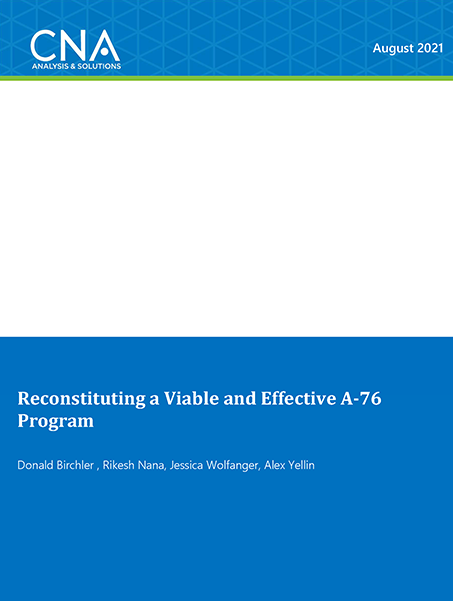Issue and tasking
The Department of Defense (DOD)is working to build a larger, more capable, more lethal force. This requires making the Department as cost-efficient and -effective as possible. One tool for increasing efficiency has been A-76 public-private competitions, a process that included an analytical framework for comparing public and private sector performance. However, the A76 process has been prohibited by statute for nearly a decade. Although the A-76 moratorium remains, the Department is considering what it would need to do in the event that A-76 became an active program again.
Due to the length of the statutory prohibition, the institutional knowledge associated with the A-76 process has been significantly degraded or lost. A thorough analysis and action plan for reconstituting the program is needed. Specific issues that must be addressed include organizational structures for administering the program, processes for implementing the program, and best practices for executing A-76 studies. A robust, effective A-76 process has the potential to allow the Department the flexibility to transfer workloads between different sources of labor (civilian and contracted services) where significant cost savings could be realized.
In addition, DOD also expressed interest in examining paths toward creating a more flexible workforce management environment. Besides the moratorium on A-76, there are other laws that prevent the full use of A-76. In addition, there may be cases where a full A-76 competition is not appropriate such as hiring contractors on a temporary basis to sunset an older existing system while transferring the current government workforce to operating a newer system. The department’s flexibility under such circumstances is hampered by laws that force it to use A76 as the only route.
Accordingly, the Total Force Manpower and Resources Directorate (TFM&RS) within the Office of the Under Secretary of Defense for Personnel and Readiness (OUSD P&R) asked CNA to make recommendations to improve the A-76 process and to consider the repercussions of changing certain laws governing the conversion of DOD functions to the private sector. Specifically, CNA was tasked to conduct a literature review and SME discussions to examine the following issues:
- What best practices and lessons learned can be gleaned from the legacy A-76 program?
- What were the deficiencies and challenges of the legacy A-76 program and how can they be addressed in a future program?
- What actionable, practical, and concrete steps need to be taken to establish an effective A-76 program?
- What policy improvements, process enhancements, additional resources, and organizational structures are necessary to ensure the viability and credibility of a reconstituted A-76 public-private competition capability in DOD?
DISTRIBUTION STATEMENT A. Approved for public release: distribution unlimited
Details
- Pages: 72
- Document Number: DRM-2019-U021583-1Rev
- Publication Date: 8/10/2021
